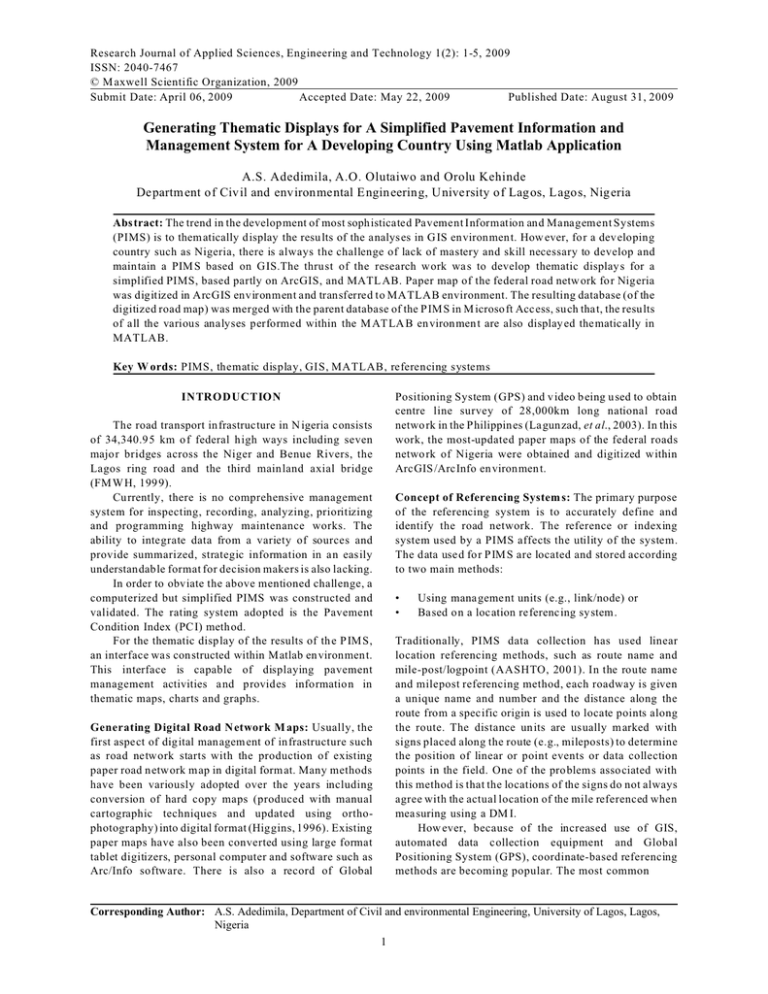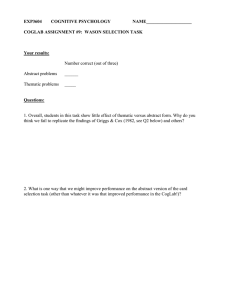Research Journal of Applied Sciences, Engineering and Technology 1(2): 1-5,... ISSN: 2040-7467 © M axwell Scientific Organization, 2009
advertisement

Research Journal of Applied Sciences, Engineering and Technology 1(2): 1-5, 2009
ISSN: 2040-7467
© M axwell Scientific Organization, 2009
Submit Date: April 06, 2009
Accepted Date: May 22, 2009
Published Date: August 31, 2009
Generating Thematic Displays for A Simplified Pavement Information and
Management System for A Developing Country Using Matlab Application
A.S. Adedimila, A.O. Olutaiwo and Orolu Kehinde
Departm ent of Civil and environmental Engin eering, University of Lag os, Lagos, Nigeria
Abstract: The trend in the develop ment of most sophisticated Pavement Information and Management Systems
(PIMS) is to them atically display the resu lts of the analyses in G IS environmen t. How ever, for a developing
country such as Nigeria, there is always the challenge of lack of mastery and skill necessary to develop and
maintain a PIM S based on GIS.The thrust of the research work wa s to develop thematic display s for a
simplified PIMS, based partly on ArcGIS, and MATL AB. Paper map of the federal road netw ork for Nigeria
was digitized in ArcGIS environment and transferred to MATLAB environment. The resulting database (of the
digitized road map) was merged with the parent database of the PIMS in M icrosoft Acc ess, such that, the results
of all the various analyses performed within the M AT LA B en vironmen t are also display ed thematically in
MATLAB.
Key W ords: PIMS, thematic display, GIS, MATLAB, referencing systems
Positioning System (GPS) and v ideo b eing u sed to obtain
centre line survey of 28,000km long national road
netwo rk in the Philippines (La gunzad, et al., 2003). In this
work, the most-updated paper maps of the federal roads
netwo rk of Nigeria were obtained and digitized within
ArcGIS /ArcInfo en vironmen t.
INTRODUCTION
The road transport infrastructure in N igeria consists
of 34,340.95 km o f federal h igh ways including seven
major bridges across the Niger and Benue Rivers, the
Lagos ring road and the third main land axial bridge
(FM W H, 199 9).
Currently, there is no comprehensive management
system for inspecting, recording, analyzing, prioritizing
and programming highway maintenance works. The
ability to integrate data from a variety of sources and
provide summarized, strategic information in an easily
understandable format for decision makers is also lacking.
In order to obviate the above mentioned challenge, a
computerized but simplified PIMS was constructed and
validated. The rating system adopted is the Pavement
Condition Index (PCI) method.
For the thematic display of the results of th e P IM S,
an interface was constructed within Matlab en vironmen t.
This interface is capable of displaying pavement
management activities and provides information in
thematic maps, charts and graphs.
Concept of Referencing System s: The primary purpose
of the referencing system is to accurately define and
identify the road network. The reference or indexing
system used by a PIMS affects the utility of the system.
The data use d for PIM S are located and stored according
to two main methods:
•
•
Using manageme nt units (e.g., link/node) or
Based on a location referenc ing system.
Traditionally, PIMS data collection has used linear
location referencing methods, such as route name and
mile-post/logpoint (AASHTO, 2001). In the route name
and milepost referencing method, each roadway is given
a unique name and number and the distance along the
route from a specific origin is used to locate points along
the route. The distance un its are usually m arked with
signs placed along the route (e.g., mileposts) to determine
the position of linear or point events or data collection
points in the field. One of the problems associated with
this method is that the locations of the signs do not always
agree with the actual location of the mile referenced when
mea suring using a DM I.
How ever, because of the increased use of GIS,
automated data collection equipment and Global
Positioning System (GPS), coordinate-based referencing
methods are becoming popular. The most common
Generating Digital Road N etwork M aps: Usually, the
first aspect of digital man agem ent of infrastructure such
as road network starts with the production of existing
paper road n etwork m ap in digital form at. Many methods
have been variously adopted over the years including
conversion of hard copy maps (produced with manual
cartographic techniques and updated using orthophotography) into digital format (Higgins, 1996). Existing
paper maps have also been converted using large format
tablet digitizers, personal computer and software such as
Arc/Info software. There is also a record of Global
Corresponding Author: A.S. Adedimila, Department of Civil and environmental Engineering, University of Lagos, Lagos,
Nigeria
1
Res. J. Appl. Sci. Eng. Technol., 1(2): 1-5, 2009
coordinate system s are the longitude an d latitude , state
plane coordinate sy stem and universal transverse
Mercator. Although many agencies use linear referencing
system for their PMS data collection and storage
(NCHRP, 2004), coordinate-based systems are also
beco ming popular.
The use of GP S has m any adv antages in term s of
location accuracy and data integration potential; how ever,
it also creates a significant challenge regarding
compatibility with historical data and interoperability with
existing systems.
The map displa y in PIM S is achieved with MATLAB
mapping toolbox using the following steps:
The digitized map is read in MA TLAB using the
functio n sha peread ()”
Fro m th e re sul t of t he sha pe rea d fu nc tion ,
the attrib ute s of the ma p a va ilab le ar e G eo me try,
Bo un din gB ox , X, Y , Id, R oa d_ Ty pe , Ro ad _N am e,
DE SC RI PT N a nd Na me .
A n attribute that is comm on to both the b ase database and the digital
ma p is sele cted .
The attribute used here is “Road_N ame”
Fro m th e re sul t of t he qu ery to th e P IM S d atab ase ,
the Road _Nam e in the various cond ition of
selected o p ti on (A D T , M a n d R A ct io n or PC I Ca tego ry) w ith resp ect to
the survey year are then m apped w ith different colours
on the map using the function:
mak esym bolsp ec(Line ,Road _N ame,co lor,LineW idth).
The map is then displayed on the specified
axes on the Graphical User Interface(GUI) using the function :
map show ().
MATERIALS AND METHODS
The d ev elo ped P IM S is customized computer
software that incorp orates knowledge-based Visual B asic
W i n d o ws® a n d M A T L A B a p p li c at io n s . T he
computational aspects of the system are implemented
using the MATLA B programming language with jet
engine-based access to database files in Microsoft Access
(mdb) format. The results and gen erated reports are
displayed in Visual Basic interface. The system is a
com pletely interactive menu-driven application.
The PIM S system is designed to operate with manual
visual cond ition surv ey of the pav eme nts. Collated field
distress data are entered in and the system autom atically
carries out PCI procedure and generates PCI condition
rating for the particular road section. The system
t h e r e af t e r r e c omm ends sug gested ap propri a te
maintenan ce and reha bilitation strategies.
A digitized federal road n etwork map was generated
using ArcInfo/Map software and d isplays in MATLAB
interface. The approach adopted for PIMS-Thematic Map
integration is the exportation of analysed results from the
PIM S and subsequent disp lay on the digitized federal
road network map, through Microsoft Access. Spatial
information on traffic, type of pavement rehabilitation and
pavement condition can be presented for the highway
system in the form of different themes. Temporal
information can be displayed based on user selection of a
particular year. The steps used in generating the thematic
displays and the summarized source code are contained in
the Appendices A and B.
Ap pendix B: Sample Pims Code for Displaying the
Map :
functio n sho wR oadM ap(R oadN ames ,Road Co lour)
%R oadN ames is an array of all roads
that fall into the respective
% catego ry
% Ro adC olour is an array of c olour
lege nds for ea ch ro ad, re spe ctive ly
%declaration
global roads
global roadSpec
road s=sh ape read ('Fina l Ro ad.sh p');
% read ing th e dig ital ma p into
% mem ory
l=len gth(R oad Na mes );
%Length of roadNames vector
RC={}; %pre allocating memory to
variable RC – Road colour
LW=[]; %pre allocating memory to
variable LW –Line weight
for j= 1:l
LW(j)=2;
if RoadColour(j) == 1
RC(j)={'y'}; %Y ellow
elseif RoadColour(j)== 2
RC(j)={'b'}; %blue
:
:
:
Ap pendix A: M ap D isplay: The map display was done
using the mapping toolbox of MATLA B. The Mapping
Toolbox is a collection of MA TLAB functions, user
interfaces, sample data sets and demos that read, write
display and manipulate geospatial data. The toolbox
supp orts standard analyses, such as line-of-sight
calculations on terrain data or geographic computations
that account for the curvature of the Earth's surface. It also
supp orts key mapping and geospatial data analysis,
manipulation and v isualization task s that are useful in
applications such as earth and p lanetary scien tific
research, oil and gas exploration, environmental
monitoring, highway m anagement, insurance risk
management, aerospace, defense and security.
else
RC(j)={'k'}; %B lack
end
end
AllRoad s=Ro adNam es;
% colour specification for each road
roa dS pe c= ma ke sym bo lsp ec( 'Lin e',...
{'R oa d_ Na me ',All Ro ads{1 },'co lor',
RC {1 },'L ine W idth ',LW (1)} ,...
{'R oa d_ Na me ',All Ro ads{2 },'co lor',
RC {2 },'L ine W idth ',LW (2)} ,...
:
:
:
2
Res. J. Appl. Sci. Eng. Technol., 1(2): 1-5, 2009
{'R oa d_ Na me ',All Ro ad s{l} ,'col or',
RC {l},'LineW idth',LW (l)});
axes(h andles .axesM ap)
%specify axes on the GUI to display the
%m ap
ma psh ow ('stat es.s hp ','Fac eC olo r',
'w','EdgeC olor',[0.95...0.5 0.1 ])
% state bou ndary
map show (gca,road s,'Symb olSpe c',roadSp ec)
% road map
RESULTS AND DISCUSSION
Generating Thematic Reports: In add ition to
presentation of survey and analysis reports in tabular
formats, the developed PIMS also has the capability of
displaying reports for the entire roads network in them atic
map formats. Tow ards this end, all the available federal
road sections within the network were digitized using
ArcMap-ArcView program (Fig. 1). Each digitized road
section was assigned a unique name (same as the federal
route num ber). Links w ere then estab lished betw een th e
digitized road section s and those road sections listed in
the PIMS database. A s such , it is possible to attach survey
and analysis results to specific road sections, which are
then appropriately displayed in the road network map.
Adopted Referencing System for the Research Work:
The primary purpose of the adopted referencin g system is
to accurately define and identify the pavement sections
within the digitized federal road network of Nigeria. This
was accom plished by e stablishing a standard section and
node system that could be utilized (in future) to store all
linear data related to road centrelines. The linear data that
could be stored include inventory of roadway features and
roadway characteristics, e.g., road width, number of lanes,
pavement thickness, etc. The linear data stored, in this
study, are basically the route number and description of
all highways within the network. An established link w ith
the MATLAB application enables the results of analyses
to be extracted and displayed for each pavement section
in the PIMS interface.
Nodes and sections of pavements within the federal
roads network map were id en tified accord in g to FM W
categorization as detailed in the Inventory of Federal
Roads (FMW H, 1999). Nodes were defined as points in
the road network and identified at road intersections or
adm inistrative/state boundaries.
State boundaries of roads were clearly identified and
demarcated. A section represents the length of a road
measured along the centerline between start and end
nodes. The node that represen ts the end of a section
defines the section’s limit and location. Fig. 2 shows the
digitized vocational referencing of a section of the federal
rural road network indicating nodes and sections.
Fig. 1:
Digitized Federal Road Network of Nigeria using
ArcMap
Fig. 2:
Locational Referencing of a Section of the Federal
Rural Road Network Showing Nodes and Sections
netwo rk of highways. The system is able to display
information spatially as well as temporally. Spatial
information on traffic (ADT ), type of pavement
rehabilitation (M and R Action) and pavement condition
(PCI Category), can be presented for the highway system
in the form of different themes. Temporal information can
be displayed b ased on user-selection of a particular year.
The flowchart for the thematic display is shown in Fig.3.
User interfaces are provided which facilitate easy
selection of the different types of display of results from
the analyses pre viously carried out in MATLAB
environm ent. The user interfaces were developed and
attached with label and tool buttons, lists and combination
boxes. The user interfaces are used to display results for
selected param eters such as ADT, M and R A ction and
PCI C ategory, for a particular year.
Them atic Displays of Historic PCI: The user se lects
‘PCI Category’ as the desired parameter, selects the
corresponding year for which information is required,
selects the type of chart (pie or bar) and thereafter clicks
on the EXECUTE button (Fig. 4, 5). The PIM S intern ally
extracts and computes, from the database, the percent
Them atic Display Cap abilities of the Developed Pim s:
The developed PIMS is capable of reporting and
displaying pavement and traffic information for the entire
3
Res. J. Appl. Sci. Eng. Technol., 1(2): 1-5, 2009
Fig. 6: Example of Thematic Map and Pie Chart of Historical
M&R Actions
Fig. 3: PIMS Thematic Display Flow Chart
Fig. 7: Example of Thematic Map and Bar Chart of Historical
M&R Actions
Fig. 4: Example of Thematic Map and Pie Chart of Historic
PCI
Fig. 8: Example of Thematic Map and Pie Chart of Historic
ADT
values of pavement true areas falling within each PCI
rating. The percent results are then auto matically
displayed for each PCI category and represented as pie /
bar chart. The Show M ap bu tton is clicked to display the
results in thematic ma p form at.
Fig. 5: Example of Thematic Map and Bar Chart of Historic PCI
4
Res. J. Appl. Sci. Eng. Technol., 1(2): 1-5, 2009
•
•
For developing countries that obviously cannot
successfully utilize sophisticated commerc ia l PIMS
software, a simpler but equally e ffectiv e
computerized more effective and attractive, graphical
display PIMS has been developed.
In order to make such developed PIMS m uch of
analyzed result in the form of charts and thematic
maps were incorporated. Though a digitized map of
the federal roads was generated within ArcView
environment, however the map is successfu lly
incorporated to display results of ana lyses w ithin
MATLAB enviro nme nt. Results are displayed in the
form of thematic maps, charts and graphs.
RECOMMENDATIONS
Fig. 9: Example of Thematic Map and Bar Chart of Historic
ADT
It was the challenges encountered in incorporating
GIS with the developed simplified PIMS that led to the
adoption of MATL AB programme for the thema tic
display purposes. However, G IS is a very po werful tool
that could really boost the ability of developed PIM S to
perform in-dep th spatial queries and display. Further
research should be geared towards the incorporation of
GIS capabilities within locally developed PIMS.
Exploring the computational strength and mapping
capa bility of MATL AB, a lot can be achieved ranging
from geospatial data analysis, manipulation and
visualization tasks that are useful in applications such as
earth and planetary scientific research, oil and gas
exploration, environmental monitoring, insurance risk
management, aerospace, defence and security.
Fig. 4 and 5 show how the PIMS displays the historic
condition of the federal rural highw ays netw ork for a
particular selected year (2008).
For the parameters used, the highway network map
shows those highway sections that have failed (red
coloured), in very poor condition (black coloured), in poor
condition (magenta coloured)and in fair condition (cyan
coloured). Similarly, the map shows sections in good
condition (green coloured ), in very good condition (blue
coloured) and those sections in excellent condition
(yellow coloured). Sections with gray colour represent
those with unavailable data. The ranges of the PCI used to
classify the condition of the pavemen t sections are also
indicated.
Them atic Displays of Historic M and R Actions:
Figure 6 and 7 show exam ples of the system's ability to
display thematic map and charts for historic M&R
activities. Having first clicked on the radio button besides
the M and R Action, the u ser selects the desired year for
which information is required and the chart type and then
clicks the EXECUT E button. Based on the previously
stored information (in the PIMS database), the system
calculates percent area for the different M and R activities
carried out on variou s road sections of the federal
highway network. The results are presented for a
particular year (Say, 2008) and displayed in different
colours. The Show M ap button is clicked to display the
results in thematic ma p form at.
REFERENCES
AA SH TO ., 2001. Pavement Management Guide,
American Association of State Highway and
Transportation Officials, Washington, D.C.
Anony mous, http://assetmanagemen t.transportation.org
/tam/aashto.nsf/docs/6BA837CC 4B56259385256C
41005BC2B8?opendocument&Group=TAM T78H
SC3&tab=REFERENCE
FM W H., 1999. Inventory of Federal Ro ads 2000. Edn.,
Federal Min istry of W orks and Housing,
M a n a g e m e n t I n f o r m a t i o n S e r v i c e s U n i t,
Headquarters, A buja. ISBN 978-070-260-2
Higgins, S., 1996. Comprehensive Pavement
Management in Georgia Utilizing the Route-System
Data Mod el. ESRI Conference Proceedings, paper
no. 170.
Lagunzad, L.V ., K. McPherson and G.P. Macaraig, 2003.
LRS and Enterprise GIS: A New Technology For
Road Ma nagem ent In The Phillipines. http://gis.esri.
com /library/userconf/proc02/pap0 451/p045 1.htm
NCHR P, 2004. Pavement Management Applications
Using Geographic Information Systems NCHRP
Synthesis 335, Tran sportation Research B oard,
W ashington D.C., www.trb.org/news/blurb_
browse.asp?id=5
Them atic Map of Historic ADT: In similar manner,
historic ADT data for any particular year (for which data
is available) can be displayed for the road sections within
the federal rural highway ne twork. Different colours of
the map show different levels of ADT on the road
sections. The different levels of ADT are shown in a
legend and d ifferentiated with colours on the charts and
the map (Fig. 8 and 9).
CONCLUSIONS
From the foregoing work, the following conclusions
and recommendation are made, viz:
5




